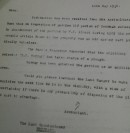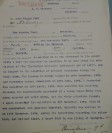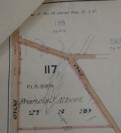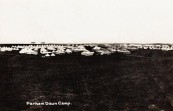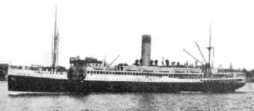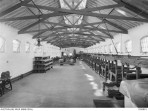ALBERT Francis Joseph
-
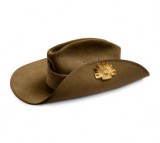
- 2332
- Private
- 5th Reinforcements, 26th Battalion, 12th Battalion, 3rd Machine Gun Company, 1st Machine Gun Company
- Beerburrum Soldier Settlement
- Yes
- 12 August 1896
- Brisbane
- 31 August 1915
- HMAT A69 Warilda
- 5 October 1915
- Brisbane
-
Francis Joseph Albert was born in Brisbane on 12 August, 1896. He was the fourth son of Joseph Albert and Frances Marion Battersby having emigrated from England around 1890. After Francis was born, they had another son and five daughters.
William (1890) Vincent (1892) Norman (1894) Francis Joseph (1896) Edwin (1896) Kathleen Mary (1898) Hilda Winifred (1901) Doreen (1907) Alice (1910) Dorothy Marion (1914)
In 1915 Francis was working as a tramway conductor for Brisbane Trams. His father was an Inspector of the trams and was probably influential in obtaining this position for his son when most young men with no qualifications were labouring in industry, mining, farming and construction. This was relative easy work for a young man of 19 who was slightly built weighing 120 pounds (54 kgs) and 5’5” (165 cms) tall. He had some military experience serving with the Oxley Regiment. Before the First World War Australia was the only English-speaking country which had a system of compulsory military training during a time of peace. The legislation for compulsory military training was introduced in 1909 by Prime Minister Alfred Deakin, and was passed into law in 1911, under the Labor government that succeeded Deakin's. The legislation provided for three levels of training: boys 12–14 years old had to enrol in the junior cadets, 14–18 year olds enrolled in the senior cadets, and 18–26 year olds had to register with the home defence militia, the Commonwealth Military Force . His original Attestation Papers were lost and new papers were filled out on board Troopship A69 on 4 November, 1915 however the embarkation rolls state that he joined up on 31 August, 1915. He had a fair complexion with blue/grey eyes and fair hair and was a Roman Catholic. He left Brisbane on board the “Warilda” as a member of the 5th Reinforcements, 26th Infantry Battalion. He reached Alexandria, Egypt on 29 March, 1916 and from there proceeded to Marseilles where men of the A.I.F. were hurried through because it was a port of doubtful attractions.
On the 17 May, 1916 he was admitted to hospital with dental cavities and was invalided to England and on the 8 June, 1916 admitted to the 3rd General Hospital with cardiac overstrain. This was the start of a downward path for Francis Albert who appeared to be dodging active service throughout his time overseas. The AIF’s men soon realised that they had signed up for a venture that could leave them horribly mutilated or dead. One way to fool the doctors into believing that the soldier was medically unfit was the iodine cigarette trick, which, smoked for an hour or so before sick parade, would give the symptoms of a bad heart or an old trick was to chew cordite to fake a heart condition. He was granted leave after being discharged from hospital and reported to Perham Down on Salisbury Plains, a training ground for the A.I.F., on 6 October, 1916. On the 17 November, 1916 he was found to deficient of his full kit issued by the A.I.F. It is possible that the kit was lost in transit or had he disposed of it with the intention of going absent permanently.
On 7 April, 1917 Francis appeared at a General Court Martial on a charge of being Absent Without Leave from 27 December, 1916 until 27 March, 1917 when he handed himself in to the Croydon Police.
“The only reason I had for stopping away was that I had got a girl into trouble and wanted to make her my wife. I expected money from AUS but did not get it and I waited from day to day but it did not come.”
He pleaded guilty and was sentenced to 120 days detention and the total forfeiture of 221 days pay which amounted to 55 pounds and in today’s monetary value would have been $AUD4888.00. At enlistment time Francis had allocated 4 shillings a day to his mother from his pay leaving him 1 shilling a day for himself and 1 shilling a day as deferred payment. Back in Brisbane, his mother, Frances Albert, would have also forfeited 44 pounds and 2 shillings whilst her son was AWL and in detention. She may well have not known why her allotment had been stopped by the army. His sentence was remitted 20 days and he was released on 16 July, 1917.
Just 5 days later he was AWL again from 21 July to 3 August, 1917. He was awarded 6 days detention and the forfeiture of 30 days pay and 10 days of Field Punishment No. 2. Field Punishment Number One, often abbreviated to "F.P. No. 1" or even just "No. 1", consisted of the convicted man being placed in fetters and handcuffs or similar restraints and attached to a fixed object, such as a gun wheel or a fence post, for up to two hours per day. In Field Punishment Number Two, the prisoner was placed in fetters and handcuffs but was not attached to a fixed object.
On two more occasions he went AWL from Perham Down from 2 September, 1917 to 13 September, 1917 and 30 September, 1917 to 7 October, 1917. The first of these offences amounted to 12 days detention and 27 days forfeiture of pay. The second offence brought another 2 days detention and loss of 31 days pay. The second offence resulted in him being court martialled again.
In his statement he said “I was granted 4 days leave as my wife was ill. At expiration of leave I was unable to return as my wife was not in a fit state of health to be left and was expecting to be confined. I sent a prepaid wire asking for an extension and did not receive a reply. My wife sent a medical certificate to the camp but this has not been received.”
His next offence was more serious on this charge sheet. He was charged with being AWL from 6 November, 1917 to 24 November, 1917 and also attempting to escape. During his time AWL he proceeded to Croydon where his wife was living and found her ill. He remained with her at Croydon until arrested by the Military Police. His wife had since given birth to a child. Whilst on escort he told Private Larnder about his position and asked him if he would take him to see his wife. He said “No”. On 25 November, 1917 when under escort by Private Larnder, ANZAC Provost Corp, from Croydon Police Station to Warwick Square in London, Albert broke away from his escort by jumping out of the train and attempted to escape. In his witness statement, Private Larnder, stated that the accused opened the carriage door and jumped out. Private Larnder immediately followed and after a chase of about 75 yards captured him and escorted him to London. The train was in motion at the time of the escape.
Francis was to be held in detention for 130 days at the Detention Barracks, Lewes and was admitted to Lewes on 22 December, 1917 and was discharged on 12 February, 1918. Some forty Australian provosts staffed Lewes, but it was no home-from-home for the bad and the unlucky who entered its iron gates. Some warders had served in Australian jails; others learned from the stern screws at the Aldershot Detention Barracks. Prisoners occupied one-man cells, mixing in the workshops and at meals, but usually in enforced silence. Apart from spending a lot of time doing nothing in bare, comfortless cells and drilling endlessly in bleak exercise yards looking at high, flint-studded walls, prisoners spent long hours sewing mail and coal bags. Few men returned and even the warders regarded working at Lewes as tedious and unpleasant.
Once again only 15 days after returning to barracks he absconded until 2 April, 1918 when he was apprehended by MPs in Warminster Road at 3.45 pm. At his General Court Martial he stated:
“I was absent last year for 18 days whilst my wife was confined. I received 5 months detention for it and was released from Lewes for good behaviour and applied for leave, not getting it. I went absent. I am anxious to go to France.”
He was sentenced to another 100 days detention back at Lewes until he was discharged on 1 July, 1918 when the A.I.F. took him at his word and he was rapidly sent to France two days later before he got a chance to abscond again.
By the 18 July, 1918 he was taken on strength with the 1st Machine Gun Battalion in the field. Since his enlistment in 1915 he had served a total of 26 days on the Western Front until he was struck down with physical exhaustion on 13 August, 1918 and was invalided back to England. Twice more he went AWL. Once for a day resulting in loss of pay for 3 days and the other time from 10 November, 1918 until 7 December, 1918 when he was sentenced to 60 days detention at Sutton Veny. He had been in the Group Clearing Hospital, Sutton Veny suffering from influenza. He had been recognised in Warwick Square by a military policeman, Private Cohen, and he had no pass and admitted that he was AWL.
He stated at his General Court Martial:
“I went absent from hospital in order to take my wife from Warminster to London to her home.”
He received 8 days off his sentence and was sent to the training battalion at Sutton Veny on 10 March, 1919.
Francis Albert did marry his pregnant sweetheart, Susan Stovell on 27 June, 1917. Although 18 years of age, on their marriage certificate it states that she was 21. They were married at The Church of the Immaculate Conception, Moulsham and she, Francis and their child would leave England on board the “Zealandic” on 23 August, 1919. Francis was discharged from the A.I.F. on 26 September, 1919. During his time in the A.I.F. Francis Albert had lost 750 days pay either by being AWL or in detention. This amounted to 187 pounds and five shillings representing today’s value at $AUD17058. His family would have suffered hardship due to his conduct and loss of pay.
The A.I.F. had suffered grievously: nearly 60,000 dead; 150,000 wounded. Overall, one man in five was dead; one in two wounded. It was relatively common for men determined to avoid front line service either to wrangle time in depots or hospital or, increasingly as the war continued, simply go absent without suffering any serious penalty. This meant that the men who remained with their battalions, who entered action repeatedly, bore the burden of battle disproportionately. “Mateship” was a real force in the A.I.F. but it was not a universal religion. For many men self-interest prevailed over mateship. These soldiers evaded battle and survived, becoming returned men.
Upon his return to Australia, Francis Albert applied for and received an allotment in the government incentive for settling returned soldiers, both Australian and British in farming activities such as fruit growing. The first land chosen for soldier settlement in Queensland was 53,000 acres near the Beerburrum railway siding on the North Coast railway line. Over the course of the scheme (1916-1929) at least 400 returned soldiers were settled in Beerburrum. The settlers were required to clear the virgin bush, establish their landholdings, build their own residence and cultivate a crop of pineapples to be harvested and sold to a State cannery for ultimate sale to consumers.
Francis Albert was allotted Plot 117 amounting to approximately 23 acres which he occupied on 18 December, 1922.. The Land Ranger, Tom Ford, visited the property on 13 April, 1923 when Albert was in residence with improvements being a house that he valued at 200 pounds, 5 acres cleared and under pines and the whole selection fenced. Ford again inspected the property on 3 December, 1924 when it was unoccupied and appeared deserted. The Land Ranger wrote to Albert regarding the selection but no reply was received. It was believed that Albert was living at Sandgate. The Beerburrum Soldier Settlement reached its zenith in 1921 with a population of 1,200 people. Thereafter settlers rapidly departed as the poor soil and low pineapple prices made it impossible for them to make a living as pineapple growers.
The next door neighbour, Mr Murray, applied to work the selection. The scheme was financed by the Agricultural Bank who held a mortgage over the property. It was hoped by the Land Commissioner to sell the assets on the property to recoup some of the money owed to the bank but it was found that the only movable article was an old spring cart, practically valueless. The house was also found to be constructed of “C” class timber and would not realise 60 pounds if sold for removal. Meanwhile the Queensland Forestry Department had made an offer to buy the property to grow pine trees and this was accepted and a cheque for 339 pounds 18 shillings was made to the bank who wrote off the loss made on the property. In today’s monetary value this amounts to $AUD25,660.00.
In 1939 Albert wrote to the Defence Department requesting his WW1 discharge papers as they were accidentally burnt along with some old papers. In 1942 he joined up again in the army for WW2. He was living at Dutton Park, Brisbane and stated that he was married with no dependent children but he named his father as his next of kin who lived at Doomben. Perhaps he and his wife were now separated. They had had four children during their marriage. He was working as a cook at Rose Café. He was accepted into the 1st General Battalion and sent to Townsville where he was a cook. At 46 years of age he would have been too old for active service. On 20 June, 1942 he was admitted to hospital with chronic bronchitis and was declared medically unfit on 15 October, 1942. Old habits die hard: he once again was charged with being AWL on 17 September, 1942 although only for 5 hours but it still brought a punishment of a fine of 5 shillings. He also lost his discharge papers for WW2 and stated that:
“I was fishing on Railway Wharf at Brisbane on 5 October, 1942 at night and accidentally fell in the river and was rescued by Water Police. Discharge being in my outside pocket and was gone when I was taken from the river.”
This seems a little odd as his discharge papers were not issued until 10 days after this event.
Francis Joseph Albert died at the age of 65 on 3 February, 1962 and was buried at the Lutwyche Cemetery, Brisbane.
- France
-
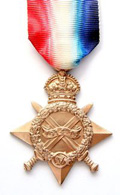
-
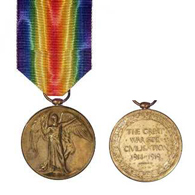
-
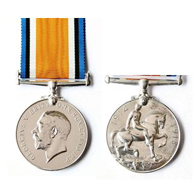
- Returned to Australia
- 23 August 1919
- 3 February 1962
- Brisbane
- 65
- Lutwyche Cemetery, Brisbane
-
Family history: Public Trees – Ancestry.com.au
Universal Service Scheme - https://www.awm.gov.au/encyclopedia/conscription/universal_service/
WW1 Service Records – National Archives of Australia
“Bad Characters” Sex, crime, mutiny, murder and the Australian Imperial Force – Peter Stanley
General Court Martial File 21881 – National Archives of Australia
General Court Martial File 21882 – National Archives of Australia
General Court Martial File 21883 – National Archives of Australia
General Court Martial File 21884 – National Archives of Australia
General Court Martial File 21885 – National Archives of Australia
Beerburrum History - Beerburrum Soldiers Settlement: https://en.m.wikipedia.org/wiki/Beerburrum_Soldier-Setlement
Documents regarding Beerburrum Selection – State Archives of Queensland
WW2 Service Records – National Archives of AustraliaImage Sources”
Brisbane Tram - https://www.google.com.au/search?q=Brisbane+tram+1910
Troopship A69 “Warilda” - http://alh-research.tripod.com/ships_lh.htm
Perham Down Camp - http://www.dontforgetthediggers.com.au/images/DATA/gallery/large_Camps-Perham.JPG
Exterior of AIF Detention Barracks, Lewes - https://www.awm.gov.au/collection/D00884/
Workshop of Lewes Prison - https://www.awm.gov.au/collection/D00891 Images of General Court Martial documents – Yvonne Atkinson
Images of Documents in State Archives of Queensland – Yvonne Atkinson - Yvonne Atkinson







